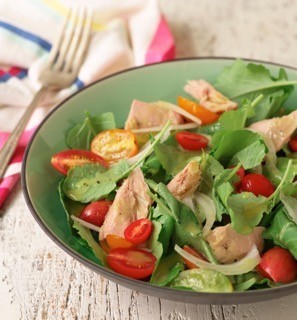Hot foods are – hot. A trend I enjoy, it has me thinking beyond chile peppers and into exploring wasabi, which is seldom used as an ingredient. I love it because instead of sending burning heat down towards my belly, it shoots a head-clearing blast up my nose, opening up my sinuses just as spring overloads them with pollen.
While creating recipes for my latest book, The Power Greens Cookbook, which came out this month, I looked for ways to use wasabi and fell in love with it in salad dressings.

wasabi root, in a powder and a paste
To make salads that work with wasabi-spiked dressings, I started by tasting wasabi together with various ingredients. The best vegetable pairings included tomatoes, cucumber, and avocado. It went well with several kinds of fish, and shrimp, as well.
So what salad dressing ingredients does wasabi blend well with? Buttermilk, and yogurt, for starters.
Wasabi added to bottled ranch dressing, with its buttermilk base, turned it into an addictively good dip served with crudités (raw vegetables).
Finally, I looked at the ultimate challenge, making a wasabi vinaigrette. Vinaigrettes are acid and oil plus flavorings. Wasabi whisked with rice vinegar, soy sauce, and roasted sesame oil is good for Asian-inflected dishes. Toss this vinaigrette with Napa and other cabbages for juicy coleslaw with a kick.
Wasabi is not good with cider or wine vinegars. Citrus juices, though, are perfect acid partners, especially for a vinaigrette used with more robust greens like kale. Thinking about fish, as well, l put together this chunky tuna salad (below). Including grape tomatoes and sweet onion, it is a colorful main dish with super-size nutrition.
I use wasabi powder from a can rather than the paste from a tube, mixing it with water to make a paste, and letting it sit 10 minutes for the heat to develop. The paste is ready-to-use but it contains both preservatives and dye. I prefer avoiding them, instead paying around $6.00 for the can, vs. $2.00 for a tube of wasabi paste. Most wasabi products list mustard and horseradish ahead of the wasabi in their ingredients because wasabi itself is expensive, so a jar of the powder with wasabi dominating costs around $9.00. Since they taste equally sharp and hot, go with the less expensive powder, or use the paste if you don’t mind the additives.
Water-packed tongol or chunk light are the canned tuna I prefer because Monterey Bay Aquarium’s Seafood Watch rates them well for sustainability and lower mercury content. I like their fuller taste together with the kale, too.
I wrote The Power Greens Cookbook to give everyone, greens lovers and people not so fond of dark leafy greens, dishes they will enjoy, and variety so you eat these valuable veggies every day. This salad proves how easy it is.







Great ideas for the use of wasabi.
The retail charges are roughly $69.